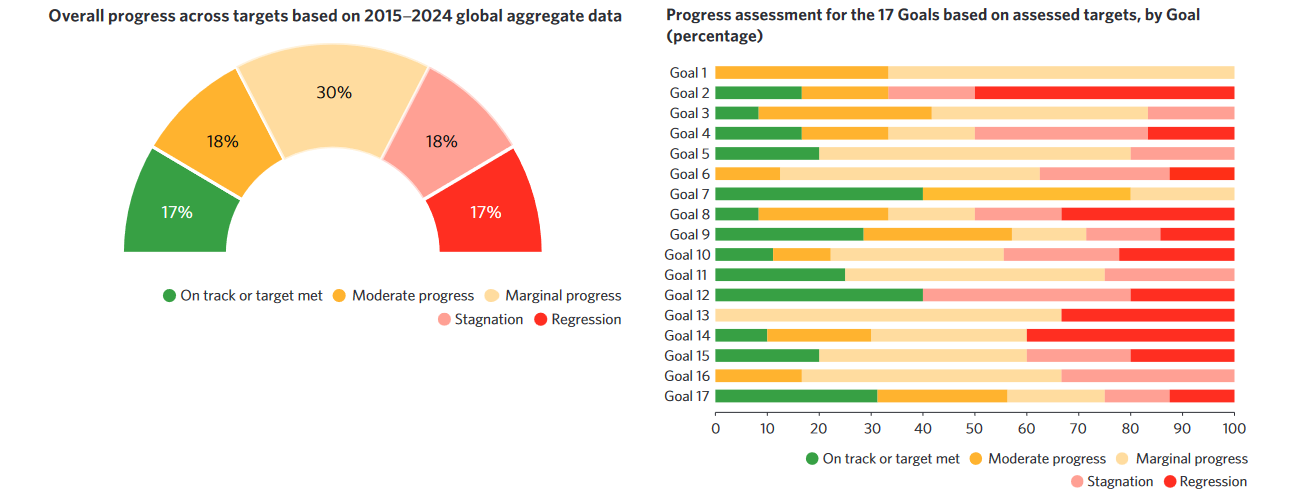
An update on the Sustainable Development Goals shows not enough progress made on the improvement targets.
The following article was published in the September-October 2024 issue of NewsNotes.
The UN convened July 8-18 at its New York headquarters for the UN High-Level Political Forum on Sustainable Development to evaluate the progress on five of the seventeen Sustainable Development Goals. The five goals discussed: No poverty, zero hunger, climate action, partnership towards goals, and lastly, peace, justice and strong institutions.
Maryknoll was represented at the UN meetings by Maryknoll Sister Margaret Lacson and Maryknoll Father John Sivalon, as well as Dan Moriarty, Peace and Nonviolence senior program officer, and Iqbal Amhad, Kroc Institute Fellow for the Maryknoll Office for Global Concerns.
The update from the UN did not paint a rosy picture. Introducing the headline messages at the forum’s beginning, UN Under-Secretary-General for Economic and Social Affairs Li Junhua shared some numbers that confirmed the belief that progress towards sustainable development has been flagging. Of the 135 measurable metrics on SDG progress that the UN and partnering organizations collected, only 17% revealed progress at the pace necessary to meet the stated goal. Roughly the same percent of the metrics showed regression against the 2015 baseline.
Meanwhile, the failure to meet the self-imposed goals was accompanied by a global erosion of trust in the United Nations, and an erosion of trust in most national governments by their citizens.
One of the least successful goal implementations was experienced by SDG1 – the alleviation of poverty. As reported by Fr. Sivalon,
“Regarding working poverty, there is tremendous regional variation with the largest number of working poor living in sub-Saharan Africa. Excluding Australia and New Zealand, Oceania experienced an increase in people experiencing working poverty. One presenter in a side event predicted that the wealth gap will continue to grow exponentially because of limited access to new technologies and especially generative Artificial Intelligence.
“The representative of the Indigenous people emphasized that rural workers are being forgotten in many of the national plans for the alleviation of poverty and that there is a real lack of democracy and an imbalance of power so that many people who are the poorest, especially women and girls, have little voice in the development of plans and strategies. Furthermore, he emphasized that a few individuals have more wealth than many countries around the world so the whole global fiscal structure needs to be restructured to increase global equity.”
The second goal covered in the conference, SDG2 – zero hunger, is intimately related to poverty. In recent years, however, the failure to address hunger and stunting has been partly the result of failures in SDG16 – peace, justice and strong institutions. War in Ukraine, Gaza, Yemen, the Democratic Republic of the Congo, Sudan, Syria, and many other areas have led to major disruption of food systems. Increased violence has also meant decreased investment in agriculture. According to a representative of the FAO, one third of arable land is degraded at this time. As a result, 1 in 10 people experience hunger, and 2.4 billion people experience food insecurity. Stunting affects 148 million children under the age of five.
On the peace front, civilian casualties world-wide rose 72 percent in 2023, the steepest rise since 2015. Among those civilian deaths, women and child made up a higher percent as compared to 2022.
But the only SDG goal for which there was no metric indicating on-track, or even moderate progress, was SDG13—climate action. The World Meteorological Organization confirmed that 2023 was the hottest year on record, with global average temperatures soaring to approximately 1.45°C above pre-industrial levels. The result has been the disruption of millions of lives and billions of dollars in economic losses. While there has been increased investment in renewable sources of energy, that investment comes nowhere near the total of fossil fuel subsidies worldwide. The scientific consensus is that emissions must be cut in half by 2030, but that is not at all likely at current rates.
Photo of the Maryknoll representatives a the United Nations, Maryknoll Sister Margaret Lacson, Maryknoll Father John Sivalon, MOGC Peace and Nonviolence senior program officer Dan Moriarty, and Iqbal Ahmad, MOGC intern. Graph below from the official UN HLPF report.

